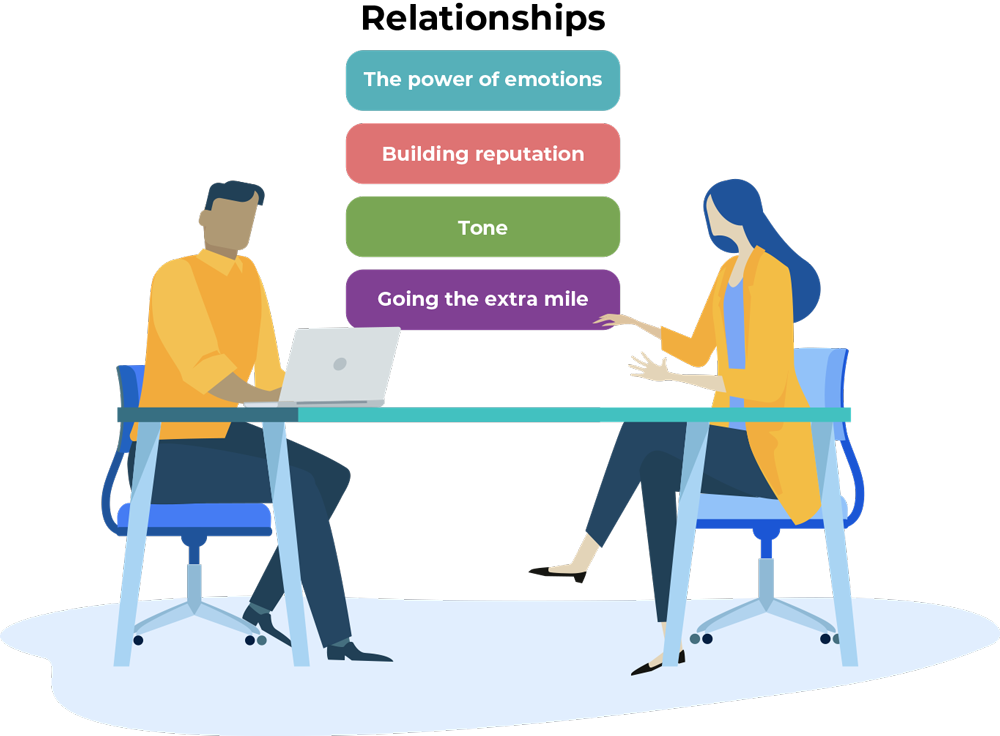4.3 Entrepreneurial Relationships with Women
2 MIN READ
Lenders know the importance of fostering good relationships with clients. Even though they have their clients’ best interests at heart, things are not always that simple.Opportunities for improvement
Here are a few comments cited in recent studies by women entrepreneurs drawing on their experiences with lending institutions:1- They felt they weren’t taken seriously.
- They stated their plans and ideas were not understood.
- They said they were not addressed first when they were accompanied by a male business partner.
- They admitted to being unhappy with the service or treatment they received.
- They felt financial institutions and their employees were too profit-oriented.
Influential lenders
According to experts, women entrepreneurs who have positive role models in their lives have a greater chance of success.2 Lenders are ideally positioned to become these role models for women entrepreneurs. In addition, lenders can not only be a strong influence on their clients, but also on their colleagues. Check out tool #8 to gather ideas on how lenders can become leading lenders.
Suggestions for fostering relationships with women entrepreneurs

- The power of emotions: Emotions significantly impact the relationship between entrepreneurs and lenders. By taking a genuine interest in a clients’ entrepreneurial journey and by using a personalized approach, there is a possibility to leverage the power of emotions by fostering stronger entrepreneurial relationships.
- Building reputation: The reputation of a lender is critical because word travels quickly in entrepreneurial circles. Take full advantage of this free publicity to build a positive reputation in the entrepreneurial network.
- Tone: Lenders can reflect on how to communicate with clients (via email, in person, on the phone) and ask themselves whether their tone helps relationships. Often, a friendlier tone can make things sound more inviting and less formal.
- Going the extra mile: If an application is rejected, explain why it was not approved and how they can improve their chances for the next time. Whether they are experienced or aspiring entrepreneurs, you never know what the future might hold.
Download & Print Tool
References
1The Beacon Agency (March 2018) Everywhere, Every Day Innovating: Women Entrepreneurs and Innovation Report, with Carleton University, BMO Financial Group, Innovation, Science, and Economic Development Canada and Indigenous and Northern Affaires Canada, p. 27.; BMO Wealth Management Report (September 2016). Are there gender differences among entrepreneurs, p. 8.
2The Beacon Agency (March 2018) Everywhere, Every Day Innovating: Women Entrepreneurs and Innovation Report, with Carleton University, BMO Financial Group, Innovation, Science, and Economic Development Canada and Indigenous and Northern Affaires Canada, p. 18.; Canadian Women’s Chamber of Commerce and Women Entrepreneurship Knowledge Hub (December 2020). Webinar: Financial Literacy 101, session # 4, Applying an Intersectional Gender Lens to Access to Capital, https://www.youtube.com/watch?v=nqX3sc5gNEg (webinar offered December 9th 2020).; Guiseppina Maria Cardella, Brizeida Raquel Hernandez-Sanchez and José Carlos Sanchez-Garcia (July 2020). “Women Entrepreneurship: A Systematic Review to Outline the Boundaries of Scientific Literature”, Frontiers in Psychology, https://www.frontiersin.org/articles/10.3389/fpsyg.2020.01557/full (page consulted September 25th 2020).; Souha R. Ezzedeen and Jelena Zikic. “Entrepreneurial experiences of women in Canadian high technology”, International Journal of Gender and Entrepreneurship, vol. 4, n° 1 (2012), p. 44-64.; Organisation for Economic Co-operation and Development (2017). Policy Brief on Women’s Entrepreneurship, p. 16-17.; Women Entrepreneurship Knowledge Hub (2020). The State of Women’s Entrepreneurship in Canada 2020, Toronto, Diversity Institute, Toronto Metropolitan University, p. 43.
2The Beacon Agency (March 2018) Everywhere, Every Day Innovating: Women Entrepreneurs and Innovation Report, with Carleton University, BMO Financial Group, Innovation, Science, and Economic Development Canada and Indigenous and Northern Affaires Canada, p. 18.; Canadian Women’s Chamber of Commerce and Women Entrepreneurship Knowledge Hub (December 2020). Webinar: Financial Literacy 101, session # 4, Applying an Intersectional Gender Lens to Access to Capital, https://www.youtube.com/watch?v=nqX3sc5gNEg (webinar offered December 9th 2020).; Guiseppina Maria Cardella, Brizeida Raquel Hernandez-Sanchez and José Carlos Sanchez-Garcia (July 2020). “Women Entrepreneurship: A Systematic Review to Outline the Boundaries of Scientific Literature”, Frontiers in Psychology, https://www.frontiersin.org/articles/10.3389/fpsyg.2020.01557/full (page consulted September 25th 2020).; Souha R. Ezzedeen and Jelena Zikic. “Entrepreneurial experiences of women in Canadian high technology”, International Journal of Gender and Entrepreneurship, vol. 4, n° 1 (2012), p. 44-64.; Organisation for Economic Co-operation and Development (2017). Policy Brief on Women’s Entrepreneurship, p. 16-17.; Women Entrepreneurship Knowledge Hub (2020). The State of Women’s Entrepreneurship in Canada 2020, Toronto, Diversity Institute, Toronto Metropolitan University, p. 43.
Disclaimer
All documents prepared for the LEADING LENDERS project were developed in line with the most appropriate and recent terminology. However, we recognize that terminology is subject to change over time. To the best of our ability, we have attempted to use terminology that respects the dignity and rights of all individuals.
All documents prepared for the LEADING LENDERS project were developed in line with the most appropriate and recent terminology. However, we recognize that terminology is subject to change over time. To the best of our ability, we have attempted to use terminology that respects the dignity and rights of all individuals.
Share:
Prev
Next

